________________
18
Geological investigation of rock sculptures around Mount Kailash
Navin Juyal and P.S. Thakker
Introduction
Kailash and Mansarovar have also been dubbed the fountainhead of the world and were recognized by early pilgrims as the source from which the four major rivers viz. the Indus, Brahmaputra, Sutlej and Karnali originate. Origin of these rivers according to geologists predates the evolution of the mighty Himalaya. Kailash Mountain is the high point of the Tibetan table land which is separated from the main Himalayan Range (lies 100 km south) by a wide low lying terrain called the Barkha plain.
In strict geological jargon, Mount Kailash is the world's highest deposit of tertiary conglomerate. Conglomerates are the naturally cemented boulders and in the Kailash area they were deposited probably during the Eocene to Miocene (between 4.5-5 million years ago). Mount Kailash is surrounded by well defined broad 'U' shaped valleys. These valleys radiate in all four directions (viz. East, West, North and South), similar to a compass and the Kailash peak constitutes the focal point which masks all other ranges in the vicinity due to its towering pyramidal feature with grooves and snow. It is the ultimate place of pilgrimage for Hindus who consider it as the abode of 'Shiva'. For Buddhists, particularly the Mahayana Buddhists of Tibet and the surrounding region, call it the mountain Kang Rinpoche, 'the precious snow mountain'. For them, this is the cosmic mountain, a link between the physical world and the spiritual universe. However, prior to the introduction of Buddhism in Tibet, the prevailing faith was the Bon Po religion and for them Kailash is the nine-storied swastika mountain, the mystical soul of the Tibetan plateau. For Jains, Kailash is known as Mount Ashtapad, where the founder of the faith Aadinath / Rushabhdev, the first Tirthankar of Jainism was said to have attained spiritual liberation (Nirvan). Subsequently his son King Bharat Chakravarti was said to have constructed a temple name Ashtapad in memory of Aadinath / Rushabhdev. This description was strengthened after the frequent visit of the Kailash Mansarovar area by Shri Bharat Hansraj Shah. According to him, there are innumerable sculptures in the vicinity of Kailash and Nandi Mountain which looks like a creation of mankind in the historical past as they also confirm well to the Jain scripture. This prompted the New York based, Jain Center of America to launch a scientific investigation in 2006. In continuation of this endeavor, another team of researchers visited the area during July-August 2007.
This report forms a part of the geological investigation carried out in the Kailash Mansarovar area with the objective to understand the evolution of the sculptured landscape particularly in
Ref. Vol. XIV Ch. 109 B Pg. 6314-6330
Geological investigation of rock sculptures...
204




